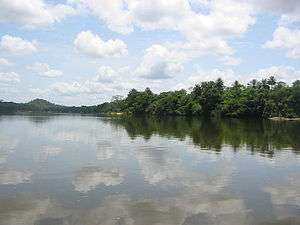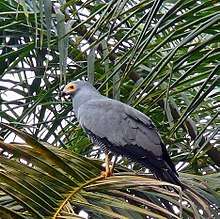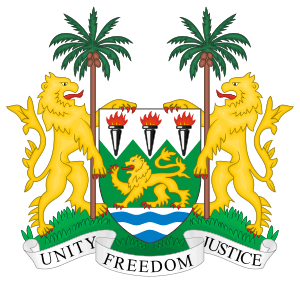Wildlife of Sierra Leone
The wildlife of Sierra Leone is very diverse due to the variety of different habitats within the country. Sierra Leone is home to approximately 2090 known higher plant species, 147 known species of mammals, 172 known breeding bird species, 67 known reptile species, 35 known amphibian species and 99 known species of fish.[1]

Mammals
There are approximately 147 known species of wild mammals within Sierra Leone.[1] Members of fourteen orders of placental mammals inhabit Sierra Leone. The endangered pygmy hippopotamus has territories around the islands on the Moa River and is widespread in the Gola Forest area.[2] There are three species of wild pig that occur across Sierra Leone: the wart hog, the giant forest hog and the red river hog.
Sierra Leone has 15 identified species of primates that include bushbaby, monkeys and a great ape, the common chimpanzee which is Sierra Leone's largest primate.[3] Chimpanzees are found across the country with the 2010 chimpanzee census estimated a wild population in excess of 5500 more than double the number previously thought to live in the country.[4] This is the second largest population of the endangered subspecies of western chimpanzee, after Guinea,[5] with the largest density in the Loma area, 2.69 individuals per km2, and the Outamba, with 1.21 individuals per km2.[6]
There are several species of whales and the African manatee in the waters of Sierra Leone. The manatee is an endangered species and lives in the rivers and estuaries of Sierra Leone especially around Bonthe.[7]
Mammals found in Sierra Leone include:
Birds

Sierra Leone has over 630 known species of bird ten of which are considered endangered including rufous fishing-owl and Gola malimbe.[8] On the coastal area there are several important sites for migratory ducks and wading birds from the Palearctic realm.[9]
- African harrier-hawk
- Black-collared lovebird
- Blue-headed wood-dove
- Iris glossy-starling
- White-breasted guineafowl
- White-necked rockfowl
- North African ostrich
- Savanna sparrow
Reptiles
There are 67 known species of reptiles, three of which are endangered, in Sierra Leone including several large reptiles. There are three species of crocodiles, the Nile crocodile, the slender-snouted crocodile which lives in forest streams, dwarf crocodile found in mangrove swamps. All the species of sea turtles live in the waters of Sierra Leone with the green turtle and leatherback turtle laying eggs on the shores including on Sherbro Island and Turtle Island. Common species of lizard include the large Nile monitor, the agama seen around settlements, the Brook's house gecko often lives inside houses, and chamaeleos.[10]
Invertebrate
Sierra Leone has around 750 species of butterflies. Including one of the largest butterflies the giant African swallowtail whose wingspan can be up to 25 cm.[11][12]
Flora
Wild flora vegetation types include the lowland moist and semi-deciduous forests, part of the Western Guinean lowland forests, inland valley swamps, wooded savannah, bolilands and mangrove swamps.[13] There are about 2,000 known species of plants with 74 species only occurring only in Sierra Leone.[9] Primary rainforest used to cover around 70% of Sierra Leone in the mid-2000s this had reduced to around 6%.[14] Common species include:
- Red mangrove which grows in swamp areas along the western coast.
- Oil palm used for palm oil and palm wine.
- Cotton tree one of which is a historical symbol of Freetown.
- Red ironwood tree
See also
References
- EarthTrends (2003). "Biodiversity and Protected Areas-- Sierra Leone" (PDF). earthtrends.wri.org. Archived from the original (pdf) on 27 October 2004. Retrieved 20 February 2011.
- "Flora and fauna of Gola". The Gola Forest Project. Retrieved 22 February 2011.
- Manson, Katrina; James Knight (2009). Sierra Leone. Bradt Travel Guides. pp. 47–48. ISBN 978-1-84162-222-4.
- Brncic, Terry M.; Amarasekaran, Bala; McKenna, Anita (2010), Sierra Leone National Chimpanzee Census (PDF), Freetown, Sierra Leone: Tacugama Chimpanzee Sanctuary, p. 8
- Brncic, Terry M.; Amarasekaran, Bala; McKenna, Anita (2010), Sierra Leone National Chimpanzee Census (PDF), Freetown, Sierra Leone: Tacugama Chimpanzee Sanctuary, p. 103
- Brncic, Terry M.; Amarasekaran, Bala; McKenna, Anita (2010), Sierra Leone National Chimpanzee Census (PDF), Freetown, Sierra Leone: Tacugama Chimpanzee Sanctuary, p. 95
- Manson, Katrina; James Knight (2009). Sierra Leone. Bradt Travel Guides. p. 51. ISBN 978-1-84162-222-4.
- "Building Conservation Capacity in Sierra Leone". RSPB. Retrieved 21 February 2011.
- Stuart, S. N.; Richard J. Adams; Martin Jenkins (1990). Biodiversity in sub-saharan Africa and its islands:conservation, management and sustainable use. IUCN. p. 19. ISBN 978-2-8317-0021-2.
- Manson, Katrina; James Knight (2009). Sierra Leone. Bradt Travel Guides. pp. 54–55. ISBN 978-1-84162-222-4.
- Allaby, Michael; Richard Garratt (2006). Tropical forests. Infobase Publishing. pp. 113–114. ISBN 978-0-8160-5322-3.
- Manson, Katrina; James Knight (2009). Sierra Leone. Bradt Travel Guides. p. 56. ISBN 978-1-84162-222-4.
- Squire, Chris (2001), Sierra Leone’s Biodiversity and the Civil War: A Case Study Prepared for the Biodiversity Support Program (PDF), Freetown, Sierra Leone: World Wildlife Fund, Washington, D.C.: Biodiversity Support Program., p. 8, retrieved 22 February 2011
- Manson, Katrina; James Knight (2009). Sierra Leone. Bradt Travel Guides. p. 46. ISBN 978-1-84162-222-4.
